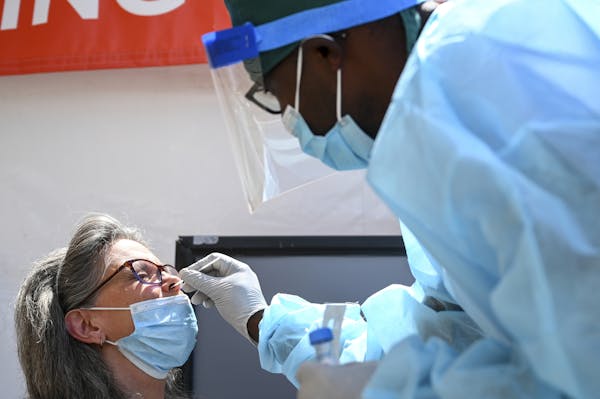Gov. Tim Walz for one of the first times Thursday suggested benchmarks for ending Minnesota's peacetime emergency and the business and social restrictions to slow the COVID-19 pandemic.
Six months after issuing the emergency order, Walz said he is looking for declines in both the positivity rate of COVID-19 diagnostic testing and the rate of infections that can't be traced to community sources.
"If we could get community spread under 20%, and we could get the test positivity rate under 4, you've got a really good chance of doing most things," Walz said in an interview at the half-year milepost of his pandemic response.
As of Thursday, the rate of cases from unknown community transmission was 35%, an indicator that the virus is spreading beyond the state's ability to track it. The positivity rate was 4.8%, an improvement from 6% late last month.
With the benefit of hindsight, Walz said there are things he would have done differently, but he struck a defiant tone against criticism that he was heavy-handed and argued that Minnesota has weathered the medical and economic tolls of the pandemic better than many states.
"We're starting to figure out how do you find that sweet spot of protecting as many people as you can while allowing things to happen," he said.
The governor's July 22 order mandating indoor mask-wearing has been controversial, but Walz said he should have declared it earlier when there was less political division.
Health officials initially discouraged mask-wearing because they feared people would use up supplies of medical-grade masks needed for doctors and nurses, but he then reversed course when studies suggested even cloth masks offered some benefit.
"I would have tried and pushed even harder than I did to have those types of things move through the legislative process so there would be unanimous approval," he said. "Because in those earlier days when we were doing that, what you got was better buy-in."
Walz has been criticized for his promotion of modeling estimates forecasting COVID-19 deaths — justifying a statewide shutdown with figures estimating 74,000 deaths without such an intervention and 50,000 with it in place. Neither came to pass — with the latest state data showing 1,942 COVID-19 deaths and 86,722 infections with the coronavirus that causes the disease.
"Thank God they haven't [occurred]," Walz said of the estimates, adding they were based on the best data about a new virus "wreaking havoc through Asia and Europe."
The state model was designed to forecast how changes such as business shutdowns would help, but Walz decided to share the underlying death estimates rather than just the trends to justify his policy decisions.
"I wanted the public to be as informed as possible," he said.
The economic toll of the pandemic and shutdown has been severe, with more than 950,000 unemployment claims filed. With estimates of a $4.6 billion state deficit, Walz said he is preparing the next budget with "every possible scenario." Neither government cuts nor tax increases can be ignored as options, Walz said, but almost all states will need more federal support.
"It is agreed by 50 governors, though Republican governors didn't want to go public and say it, but all states are going to need some help because they can't deficit spend," he said.
The governor in March prepared Minnesotans to view the pandemic as a long winter rather than a quick-striking blizzard, but its duration has exceeded his expectations and is diminishing hopes of a "V-shaped" economic recovery. Certain lucrative sectors such as business travel through the Minneapolis airport might never recover amid a business climate that has embraced online meetings.
Business restrictions aren't solely to blame given experiences in states such as Wisconsin that don't have them, Walz said. "The water show over there closed — Tommy Bartlett. And what he said was he didn't have any mandate to close, but nobody's showing up."
Walz acknowledged criticism of a $6.9 million expenditure on a cold-storage warehouse for storing bodies if COVID-19 deaths filled up morgues, but he said it was like an insurance policy he never wanted to use. He said it might find a second purpose, because mass doses of COVID-19 vaccine will need cold storage before they are distributed to hospitals and clinics.
Hospital resources have strengthened and are in good position for a "twindemic" of flu and COVID-19 this winter, the governor said. Manageable case growth also is allowing for reconsideration of things such as the cancellation of certain high school and college sports.
The Twin Cities area has been an anomaly to federal health officials because it didn't see a big spike in cases like other metro areas.
At the start of the pandemic, Walz had said that Minnesota had intervened too late to flatten the growth curve in cases, and that the best it could do was delay the spike until hospitals had time to prepare.
Now, Walz said maybe Minnesota flattened the curve after all — with one consequence being the prolonged pain of modest case growth.
"This isn't even a plateau," he said. "This is the world's largest mesa, it feels like. It's just gone on. What that's done is, it's allowed us to have indoor dining, it's allowed us to go back to school, it's allowed us to do a lot of things — but not at 100%."
Jeremy Olson • 612-673-7744

Minnesota State Patrol celebrates diverse new class of troopers

Fired Mpls. teacher accuses management of 'cancerous rot'

Jill Biden rallies women, teachers for the Biden-Harris ticket in Bloomington speeches
Neighbors, city officials at odds over Rochester lake dam

